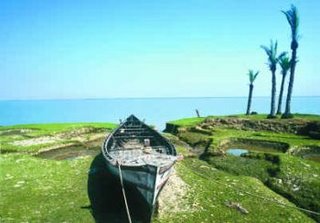Going under

We were going to see the sinking island, the tiny five-square-kilometre piece of land wrapped by the Hooghly and Baratala rivers as they flow into the sea in the western part of the Sundarban delta in West Bengal. We were going to the land of the `hungry tide', to witness the great human tragedy of homes and farmlands washed away by rivers and creeks that carry the salty waters of the sea they flow into. It was only a four-hour journey from Kolkata, by bus up to Kakdwip and then by boat to the Ghodamara (pronounced `ghoramara', with the tongue rolling over the first `r' sound) island; but it seemed to take us several worlds away.
We started meeting the people we were looking for as soon as we got on the boat, around 9 a.m. on a sparkling November morning. They were returning home on the first of the only two motorised boats that ferry every day to and from Ghodamara and Kakdwip, the island's closest point of contact with the mainland. Most of them were fishermen and farmers, wiry men and women with sunburnt faces. Almost all of them said that their families once owned "a lot of land" now swallowed up by the angry waters that surround their existence. A media team immediately arouses interest in this part of the world, not least because it seems to come from a mysterious world of the written word, from the city that is so close and yet so far. As we sailed further away from the mainland, moving across a river so wide that the bank soon became invisible, they warmed up to the story of their sinking island.
Haldia was once so close to Ghodamara that people could carry out shouted conversations across the river, said Nasir Mia, son of a schoolmaster but himself a school dropout who goes out to fish on the high seas to feed his family. But now the river has widened, claiming huge chunks of the island, and Haldia is just a speck in the horizon. Later that day, villagers on Ghodamara would point to ships far out in the mouth of the Hooghly, close to the Haldia port, and say that they sailed over what once were paddyfields. That was probably not an exaggeration; experts say that by 2001, Ghodamara was reduced to 59 per cent of what its size was in 1969.
Researchers say the island will go under in another 14 years, as two other smaller islands - Lohachara and Supuridanga - have done in the past 20 years. Supuridanga was not inhabited, but the sinking of Lohachara displaced 6,000 people, mostly marginal farmers and fishermen. The prediction is that the rising sea level will sink a dozen (six of them inhabited) more islands in 15 years, creating thousands of environmental refugees. Ghodamara has been steadily sinking for the past 25 years, though local residents say the erosion has slowed down in the recent past. Fifteen to 20 years ago, the island had a population of about 20,000 people; according to the 2001 Census, it has 5,236 people.
from Frontline (India)


0 Comments:
Post a Comment
<< Home